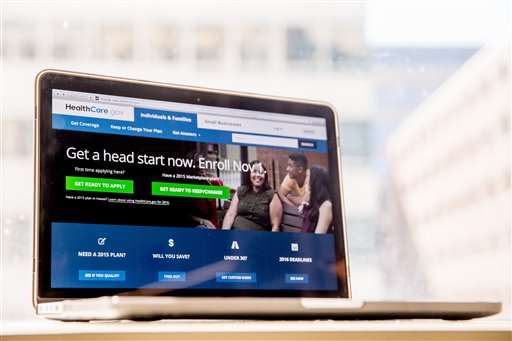Study: To avoid higher health law premiums, switch plans

Maybe an amiable gecko could help the Obama administration sell its health insurance overhaul.
In the long-running auto insurance commercials, the talkative little mascot promises you can save 15 percent if you switch insurers. Now a study says the most popular health law plans are raising premiums an average of 15 percent for 2016. You'll have to switch if you want to pay less.
Wednesday's research paper from the nonpartisan Kaiser Family Foundation comes as sign-up season for subsidized private coverage under President Barack Obama's law is in its third week. Due to rising premiums, high out-of-pocket costs, and skeptical consumers, the administration faces challenges trying to grow the pool of people covered through the law's online insurance markets.
The study looked at a type of coverage called the "lowest cost silver plan," which is the health law's most popular. Silver is the middle tier, and the lowest cost silver plan can be different in every community. The catch is, the lowest cost silver plan can also change every year. If your plan holds that distinction this year, odds are it won't have it in 2016.
Looking at data across 36 states, the analysis found that a hypothetical 40-year-old faced an average premium of $264 for the lowest cost silver plan in 2015. If the consumer stays in the same plan for 2016, his premium would be $304, or 15 percent more. That's before taxpayer-financed subsidies, which lower the final cost for consumers.
"The bottom line is that insurance companies are increasing premiums for what had been the lowest cost silver plan," said Cynthia Cox, lead author of the study. "In many cases, people could save money on their premiums by switching to a new lowest cost silver plan."
The study found that's the case in about 3 out of 4 counties. Among all consumers, those who switch could save $322 over the course of the year.
The Obama administration didn't quarrel with the findings. Also on Wednesday, the government released a statistical snapshot for the second week of open enrollment. It showed that nearly 535,000 people picked a plan in the 38 states served by HealthCare.gov. Most were returning customers, but officials could not say how many had switched plans.
The drafters of the health care law intended to create a competitive market in which consumers would seek out bargains and insurers would feel continual pressure to keep premiums low. But last year, only about half of renewing customers actively shopped for a new plan. The process can be daunting, because in addition to premiums, consumers have to consider variables like the deductible, cost-sharing, copayments, and a plan's provider network.
The Kaiser study seemed to reflect what some enrollment counselors are running into this sign-up season.
"People who had the cheapest plan last year are seeing a big increase," said Elizabeth Colvin of Foundation Communities, a nonprofit that serves low-income people in Austin, Texas.
Colvin said it's critical for low-income workers to get a silver plan, even if it's not the cheapest one, because silver plans have additional subsidies, on top of the ones that help pay for premiums.
Of the health law's four coverage levels—bronze, silver, gold, and platinum—silver plans are the only ones that offer added cost-sharing assistance to reduce deductibles and copayments when patients actually go to use their insurance.
Cost-sharing subsidies are provided on a sliding scale, based on income. With the subsidies, the average silver plan deductible drops from $3,064 to $221 for those making up to 150 percent of the federal poverty line, which is $30,135 for a three-person household, or $17,655 for an individual, according to Kaiser. A deductible is the amount of medical costs customers must pay each year before their insurance kicks in.
"The cost sharing is what makes this insurance work," said Colvin.
Dec. 15 is the last day to make changes or sign up for a new plan that would take effect Jan. 1. Open enrollment ends Jan. 31.
© 2015 The Associated Press. All rights reserved.


















